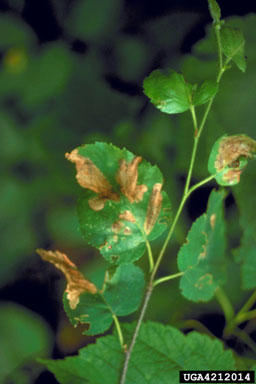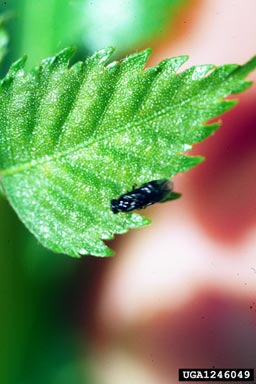DACF Home → Bureaus & Programs → Maine Forest Service → Forest Health & Monitoring → Forest Pest Index → Birch Leafminers
BIRCH LEAFMINERS
Birch is host to a number of leaf-mining sawflies. Two of the more common miners are Messa nana (Klug) and Fenusa pusilla (Lepeletier).
Symptoms and Damage

Photo: Minnesota Department of Natural Resources Archives, Minnesota Department of Natural Resources, Bugwood.org
Some of the most prevalent, and widespread causes of browning of birch leaves in Maine has been by one or the other of these European insects. Damage is a result of feeding between the upper and lower leaf surface by the larval stages. Early symptoms of attack are tiny grayish or discolored blotches in the leaf tissue surrounding the eggs. Eggs of M. nana are laid along the serrated leaf margin and larvae mine toward the center of the leaf. Eggs of F. pusilla are laid away from the leaf margin and larvae mine toward the margin. Mines appear roughly ten days after the eggs are laid and are translucent green at first. As the irregularly shaped mines become progressively larger they turn brown and cause the leaves to become wrinkled and distorted.
While both species can be an aesthetic problem especially on ornamentals, only M. nana appears to impact forest stands where it is often associated with the birch casebearer, Coleophora serratella. The combination of these two species can result in tree stress and may hasten infestation by the more destructive bronze birch borer, Agrilus anxius.
Hosts
The predominant miner on white birch in recent years has been Messa nana. This species also attacks gray and yellow birch as well. Fenusa pusilla, on the other hand prefers gray birch or gray birch hybrids. The ornamental European white birch and its cut-leaf varieties are attacked by both of these sawflies. Trees growing in open, sunny areas such as around homes and along roadsides seem to be preferred and frequently suffer the heaviest browning.
Life Cycle

Photo: Whitney Cranshaw, Colorado State University, Bugwood.org
Whereas M. nana appears to have only a single generation in any one year there may be 3-4 generations of F. pusilla. Both sawflies appear to commence activity at roughly the same time each spring however. The small black sawflies, which somewhat resemble black flies, start crawling over leaves in late May, soon after the foliage develops, and lay eggs in the leaf tissue. Emerging larvae mine as described above. The small flat pale colored larvae have various dark spots as they mature and leave their blackish specks of frass (waste material) within the mines. Larvae eventually leave the mines, drop to the ground and pupate in the soil. Pupae of M. nana remain there until the next spring whereas those of F. pusilla produce a new generation of adults to start egg laying again within 10-14 days.
Control*
Good control depends on early, timely spraying for the first generation of sawflies and larvae to prevent appreciable numbers in any later generations. The best way to time the first application is to watch the new leaves as they first develop in May. Areas in leaves where eggs have been laid will develop a grayish cast rather than the normal green of the leaf. Developing mines will show up as tiny translucent spots of a lighter green color than the rest of the leaf when leaves are held up to the light. As soon as either the transparent spots or offcolor areas appear, foliar treatments should be applied thoroughly over the whole tree. A repeat spray may be necessary 10 to 14 days later if new symptoms appear. A number of insecticides including carbaryl, malathion, and acephate will all provide effective control against birch leaf miners, however, first check the insecticide label on the container for specific use and apply only in accordance to label instructions and precautions.
A systemic insecticide, disulfoton granular also provides excellent control against birch leaf miners. However, it is a restricted use pesticide to be sold only by licensed dealerships to certified pesticide applicators only. Disulfoton is applied as granules spread over the ground beneath the affected tree and thoroughly soaked with water in accordance with specific label use instructions and precautions. Disulfoton should be applied by mid-May to be most effective.
*NOTE: These recommendations are not a substitute for pesticide labeling. Read the label before applying any pesticide. Pesticide recommendations are contingent on continued EPA and Maine Board of Pesticides Control registration and are subject to change.
Caution : For your own protection and that of the environment, apply the pesticide only in strict accordance with label directions and precautions.
MAINE DEPARTMENT OF AGRICULTURE, CONSERVATION AND FORESTRY
Maine Forest Service - Forest Health and Monitoring Division
April 2000